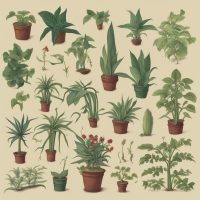Understanding the Risk: Household Plants with Harmful Effects
Improving the aesthetic appeal of a home or workplace with greenery is a common practice. It adds life and color to any space while simultaneously providing health benefits, such as improving air quality. However, not all houseplants are created equal. Some indoor plants, while beautiful and alluring, may pose significant risks to humans and pets. It is therefore imperative to understand the potential hazards some household plants can present.
Many household plants are known to contain various toxins, some of which can be harmful to humans and pets upon ingestion or even through mere physical contact. Common symptoms of plant poisoning can include but are not limited to skin irritation, nausea, vomiting, and in severe cases, even organ failure. These risks are why it’s vital for homeowners to be fully informed and vigilant when choosing plants to bring inside their homes, to ensure the safety of all household members.
Recognizing Toxic Indoor Plants: A Visual Guide
Our indoor oasis of greenery can be as dangerous as it is charming if we unknowingly invite harmful plants into our homes. All too often, the danger lies beneath the lush leaves and vibrant blooms of common household shrubs, advocating for the necessity to recognize and understand the visual characteristics of toxic indoor plants. Particularly, the Dumb Cane (Dieffenbachia) distinguishes itself through its thick, lush, and varied green leaves, a feature that masks its harmful effects. Meanwhile, Sago Palms offer a visual treat with their leathery, feather-shaped fronds, and yet, every part of this plant is known to be toxic.
A keen eye may also observe the distinctive split leaves of the Philodendron, a houseplant favorite, but deceptively dangerous if ingested. Equally alarming is the eye-catching English Ivy with its beautifully lobed leaves and climbing capacity. Its deep-rooted charm camouflages a significant threat as it, too, belongs to the list of poisonous houseplants. Therefore, it is crucial to not just admire the decorative and aesthetic aspects of these indoor beauties but to discern their potentially hazardous nature as well, ensuring a healthy and safe indoor environment.
Unmasking the Venomous Nature of Common Houseplants
In our homes, some plants, despite their decorative appeal, harbor a less than friendly characteristic – a venomous nature. These common houseplants often found sprinkled around our homes or anchored on window sills, can pose a secret threat due to their inherent toxic properties. Many of us remain oblivious to this hidden danger, admiring the vibrant splash of green they add to our indoor spaces, or appreciating their air purifying capabilities. A common mistake made by homeowners is neglecting to research houseplants before bringing them into their homes, hence, the importance of understanding the risk they pose cannot be overstressed.
It is essential to note that not all houseplants are harmful. There are numerous benign and beneficial green beauties out there. However, some, like Dieffenbachia or ‘Dumb Cane’, peace lilies, and philodendrons contain toxic saps, which when ingested or exposed to the skin may induce allergic reactions or even more severe health problems. Other plants such as snake plants or mother-in-law’s tongue, although renowned for their air-purifying properties, can turn out to be harmful when ingested. In homes with pets or small children, these plants could cause an unexpected visit to the emergency room. Hence, a place of splendor can quickly become a place of danger, emphasizing further the need to unmask the venomous nature of common houseplants.
The Hidden Threat in Your Living Room: Poisonous Houseplants
Houseplants bring a refreshing touch of green to our living spaces, improving air quality and boosting mood levels. However, many of these plants, despite their beauty, hide a lesser-known, sinister aspect: toxicity. Unfortunately, as plant owners, we often overlook this fact, unknowingly introducing hazardous elements into our homes. Some species of common houseplants can pose serious health risks if ingested or touched, turning your cozy living room into a hidden field of potential dangers.
Among the countless species of indoor plants, a significant number are poisonous, such as Dieffenbachia, English Ivy, and Elephant Ear. These plants secrete a milky, irritant sap that, if ingested, can cause painful symptoms like mouth swelling, stomach pain, and in severe cases, suffocation. Children and pets are often at the highest risk due to their natural curiosity and tendency to explore the world through taste and touch. Therefore, careful plant selection and placement become an integral part of creating a safe living environment amidst our love for indoor greenery.
Immediate Actions: How to Handle Harmful Houseplants in Your Home
Dealing with harmful houseplants necessitates a blend of prudence and awareness. First and foremost, it’s essential to educate yourself about the various types of houseplants, their toxicity levels, and the potential harm they can inflict on children and pets. Sometimes, it’s not just the ingestion, but the physical contact with certain plants that can lead to adverse reactions, such as rashes and irritations. Incorporating protective measures, such as placing potentially harmful plants in inaccessible areas and regular monitoring of the environment, can drastically reduce the risk associated with toxic houseplants.
Moreover, it’s crucial to practice responsible disposal methods for houseplants you’ve determined to be hazardous. Never dispose of them recklessly where they could pose a threat to wildlife or others. Utilize local recycling or composting sites that are equipped to handle such plant material, or consult a local horticulturalist for professional advice. In the event of accidental ingestion or contact, it is imperative to seek immediate medical assistance, ensuring to bring along a sample or picture of the plant for accurate identification and treatment. Prevention is, of course, the best approach, but knowing what to do in an emergency can save a life.























